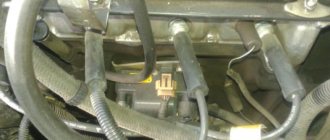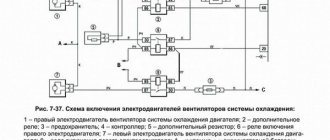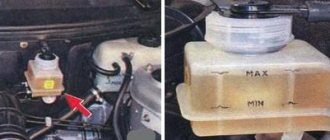Operating principle of TPS
There are two types of devices: resistive and non-contact. They differ in design, operating principle and service life.
- Resistive TPS is a variable resistor, the resistance of which changes as the slider moves along the tracks. Due to their simple design and affordable price, they are most common in the automotive industry. The Chevrolet Niva rolls off the assembly line with just such resistive devices.
- Non-contact TPS is based on a circuit that includes a magnetic field sensor and a microcontroller. They last longer and consume less electricity than resistive ones. However, contactless devices are more expensive, and the semiconductor microcontroller can burn out due to sudden voltage surges in the on-board network.
The installation location and operating principle of the TPS does not depend on the design. It is mounted on the throttle shaft. When the throttle position changes, the output voltage at the sensor changes from 0.7 to 4 volts. Due to this, the ECU receives information from the degree of opening of the damper. Based on the information received from the sensor, the composition of the air-fuel mixture is formed. Therefore, the throttle response and efficiency of the engine depend on the performance of the TPS.
Operating principle of the sensor
There are two designs of the sensor:
- Resistive is a classic potentiometer with a film track and a movable contact located on the rotation axis. As the slider moves along the track, the resistance changes. The ECU instantly receives information about the angle of rotation of the damper.
Simple design, reasonable cost. The standard equipment of Niva Chevrolet engines is with exactly these sensors. The only drawback is that over time the tracks are erased, the TPS gives incorrect information or does not work at all. Requires regular replacement. - Non-contact magnetic sensor. Inside there is a magnetic field sensor and a microcontroller that converts information about throttle rotation into a format familiar to the ECU.
Such a device lasts a long time, since it has virtually no wearing parts, and gives more accurate readings. However, the complexity of the sensor in the presence of a microcontroller makes it dependent on operating conditions. For uninterrupted operation, a stabilized supply voltage is required. With a slight deviation, the electronics fail. Of course, the cost of such a device is somewhat higher than its resistive counterpart.
Symptoms of a problem
You can accurately determine the condition of the throttle position sensor only using a scanner or voltmeter. However, malfunctions also have external manifestations:
- Decrease in engine power.
- Deterioration in engine response when pressing the accelerator.
- Gasoline consumption is increasing.
- The engine runs unstably at low or high speeds.
- The car accelerates jerkily.
- Idle speed changes randomly or the engine stalls when the gas pedal is released.
- The yellow “Check engine” light on the instrument panel is on.
Most often, problems arise with resistive type devices. In them, the conductive layer on the tracks is erased or contaminated.
As a result, the voltage changes nonlinearly when the damper is turned.
Also, the moving core in the sensor may break. In this case, it does not respond to throttle movements at all.
Basic functions of the device.
To control the speed of movement, a special device is installed on the dashboard - a speedometer. But it only displays the information received, and the speed sensor is responsible for collecting data. If it fails, it will create many dangerous situations on the road, since it will become difficult to control the speed limit in the city and on the highway.
But besides this, thanks to the integration of the electronic control unit into the system, the speed sensor allows you to perform the following functions:
- fuel consumption control
- displaying information on the instrument panel
- in cars with an automatic transmission it is included in the complex responsible for engine control
In case of failure, you are allowed to continue the journey, but this will become difficult.
Historically, there were two types of sensors. Initially, mechanical or optoelectronic were used. They read the number of shaft revolutions, transmitting it to the instrument panel using a cable. Then electronic cableless systems came to replace them.
How to check TPS?
To diagnose the throttle position sensor, you will need a multimeter or scanner that reads the on-board computer.
The test consists of monitoring the voltage at different throttle positions. To do this you need:
- Disconnect the wires from the sensor connector.
- Turn on the ignition.
- Connect a multimeter in voltmeter mode to the contacts.
Tip: you can find out the functionality without measuring instruments in a simple way - install a known working part from another car. If the symptoms disappear, the problem is in the sensor.
When the accelerator pedal is released, the device should show 0.7, and when pressed all the way - 4 volts. You also need to make sure that when you smoothly change the position of the accelerator pedal, the voltage changes smoothly.
If the multimeter readings do not correspond to the nominal values or change abruptly when the damper position is gradually changed, the part needs to be replaced.
contents .. 1 2 3 4 ..Throttle position sensor (TPS) of the Chevrolet Niva engine (controller M7.9.7)
The throttle position sensor (Fig. 1.1-05) is installed on the side of the throttle pipe opposite the throttle control lever (Fig. 1.1-06).
The TPS is a potentiometric type resistor, one of the terminals of which is connected to the reference voltage (5 V) of the controller, and the second to the controller ground. The third pin, connected to the moving contact of the potentiometer, is the output of the TPS signal.
When the accelerator pedal is moved, the throttle shaft transfers its rotational motion to the TPS, causing the TPS output voltage to change.
When the throttle valve is closed, the TPS output signal should be within 0.3. ..0.7 V. When the throttle valve is opened, the output signal increases, and when the throttle valve is open (76...81% according to the DST-2M device), the output voltage should be 4.05...4.75 V.
By measuring the output voltage of the TPS signal, the controller determines the current throttle position. The controller needs data on the throttle position to calculate the ignition timing, the duration of injection pulses and the state of the idle air control.
By monitoring the voltage change, the controller determines whether the throttle valve is opening or closing. The controller perceives the rapidly increasing voltage of the TPS signal as evidence of an increasing demand for fuel and the need to increase the duration of injection pulses.
TPS is not regulated. The controller uses the lowest TPS signal voltage at idle as a reference point (0% throttle opening).
Breakage or loosening of the TPS fastening can cause instability in idle speed, because the controller will not receive a signal to move the throttle valve.
If a malfunction occurs in the TPS circuits, the controller stores its code in its memory and turns on the alarm. If this happens, the controller calculates the throttle position based on the engine speed and air mass flow.
Removing TPS
1. Turn off the ignition.
2. Disconnect the wire from the negative terminal of the battery.
3. Disconnect the wires from the sensor.
3. Unscrew the two screws securing the sensor to the throttle pipe and remove the sensor from the throttle pipe.
Installation of TPS
1. Install the sensor on the throttle pipe. In this case, the throttle valve should be in the normally closed position.
2. Tighten the two sensor mounting screws.
3. Connect the wires to the sensor.
4. Connect the wire to the negative terminal of the battery.
5. Check the sensor output signal as follows:
— connect the SHG-2M diagnostic device, select mode “1 - Parameters; 4 — ADC channels, POL.D.Z.”;
- with the ignition on and the throttle valve closed, the sensor output voltage should be 0.3... 0.7 V. Then slowly open the throttle valve - the sensor output voltage should increase to 4.1... 5 V. If it is outside the ranges - replace the sensor.
contents .. 1 2 3 4 ..
Replacing TPS on VAZ-2123
Replacing the sensor does not require any special tools. All you need is a Phillips and flathead screwdriver. If you want to solve the problem once and for all, buy a contactless device from Bosch or General Motors.
To replace the throttle position sensor, proceed as follows:
- Use a screwdriver to pry up the rubber clips and remove the decorative engine cover.
- Remove the wire block from the connector.
- Use a Phillips screwdriver to unscrew the fastening screws.
- Remove the sensor and insert a new one.
- Tighten the screws.
- Put on the wire block.
- Return and secure the decorative engine cover.
Tip: if the voltage on the resistive sensor changes jerkily, there is a chance to restore its functionality. Remove the part, insert a flat-head screwdriver into the hole that fits onto the throttle shaft and twist it back and forth without any extra effort for a minute. This will help remove contamination from the resistive tracks and the device will begin to work correctly.
The design of the Chevrolet Niva does not require adjustment of the throttle position sensor. If the voltage at its output differs from the nominal one, the part is faulty and must be replaced.
Cleaning
Using a special aerosol to clean the remote control without dismantling it is possible only when it is lightly soiled. Therefore, if problems arise, it is better to dismantle the throttle and remove dirt using a carburetor cleaner.
For this you will need:
- Phillips and flathead screwdrivers.
- 13mm head with extension.
- A can of cleaning product (“Carb & Choke Cleaner” or equivalent).
Attention: cleaning of the diaphragm must be performed after the engine has cooled down. Otherwise, there is a risk of getting burned by the coolant or hot parts of the engine and throttle.
To clean the throttle valve, you must perform the following steps:
- Remove the ground wire from the battery.
- Remove the plastic engine screen.
- Loosen the air duct clamp.
- Remove the air supply hose from the fitting on the throttle body.
- Loosen the clamps and remove the crankcase ventilation, coolant and adsorber pipes from the throttle pipes.
Attention: place a small container under the cooling system hoses to collect antifreeze.
- Bend the cooling system pipes upward and tie them to the hood pillar.
- Disconnect the wiring harness from the throttle position sensor (TPS).
- Disconnect the terminal from the idle speed control.
- Remove the spring clip from the drive pulley and unhook the cable.
- Unscrew the two nuts securing the throttle assembly.
- Remove the throttle.
- Unscrew the fastening screws and remove the idle speed control and TPS.
- Treat the insides of the throttle body with a cleaning agent.
Due to the fact that the liquid from the can is supplied under pressure, it effectively washes away plaque.
Reassembling the mechanism after cleaning is performed in the reverse order. Before installing the clamps, they should be lubricated with machine oil. This makes tightening easier and increases the reliability of the connection.
Here we describe in detail the procedure for removing and cleaning it yourself.











